Starlink's satellite broadband is demonstrating overwhelming performance over its rivals

Speedtest.net, a speed measurement site for Internet lines, has announced the performance measurement results of satellite broadband companies that are developing Internet services worldwide. This revealed that SpaceX's 'Starlink' led by Elon Musk boasts overwhelmingly higher performance than competitors, but is slowing down due to the increase in users.
Starlink Expands but Q3 2021 Performance Flattens in Some Areas
Elon Musk's Starlink sees average download speeds fall as more users join --SiliconANGLE
https://siliconangle.com/2021/12/21/elon-musks-starlink-sees-average-download-speeds-decrease-users-join/
The following is a comparison of median internet speeds in the third quarter of 2021 with satellite broadband Starlink, HughesNet, Viasat, and all fixed broadband lines in the United States. Starlink's download speed dropped from 97.23 Mbps in the previous quarter to 87.25 Mbps, which is believed to be the result of an increase in the number of users.
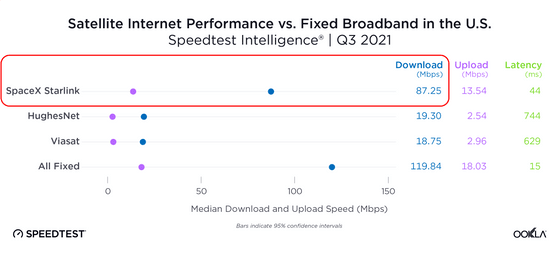
Even so, the number of 87.25 Mbps is overwhelming, far behind the competing HughesNet's 19.30 Mbps (slightly reduced from 19.73 Mbps in the previous term) and Viasat's 18.75 Mbps (slightly reduced from 18.13 Mbps in the previous term) and approaching the fixed broadband of 119.84 Mbps. Showed strength.
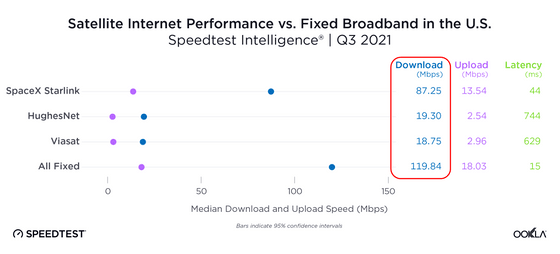
In terms of upload speed, Starlink was 13.54 Mbps (13.89 Mbps in the previous term), which was close to the fixed broadband performance of 18.03 Mbps. By comparison, Viasat was 2.96 Mbps (3.38 Mbps) and HughesNet was 2.54 Mbps (2.43 Mbps). The

If you look at the figure below, which shows a low earth orbit at an altitude of 2000 km or less in light blue and a geosynchronous orbit at an altitude of 35,786 km with a black dashed line, you can see that Starlink is quite close to the earth as a satellite.

The survey found that Starlink performs close to fixed broadband in the United States, but it already outperforms fixed broadband in some regions. For example, Starlink in Australia, located in the southern hemisphere, has a download speed of 138.12 Mbps and an upload speed of 22.63 Mbps, which exceeds Viasat's 15.6 Mbps / 1.04 Mbps and fixed broadband 51.17 Mbps / 18.03 Mbps, respectively, except for latency. It showed a performance that greatly separated the service.
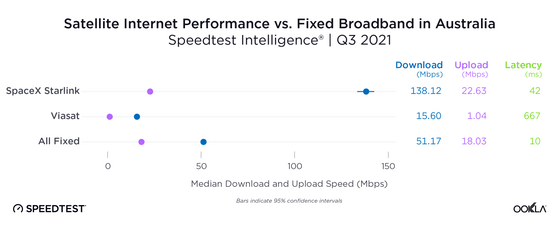
In Belgium, the download speed of Starlink is 127.46Mbps, which overwhelms the fixed broadband of 72.9Mbps. The upload speed was 16.73 Mbps, which was only slightly slower than the fixed broadband of 17.98 Mbps.
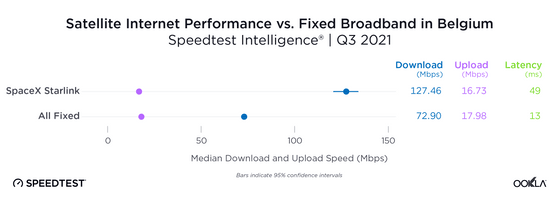
Even in the UK, Starlink has a download speed of 111.66 Mbps and an upload speed of 16.03 Mbps, which is higher than the fixed broadband of 53.16 Mbps and 15.77 Mbps. However, the higher the performance, the higher the cost. For example, in France, a general fixed broadband line is offered for less than 30 euros (about 3800 yen) per month, but Starlink costs 99 euros (about 13,000 yen) per month.
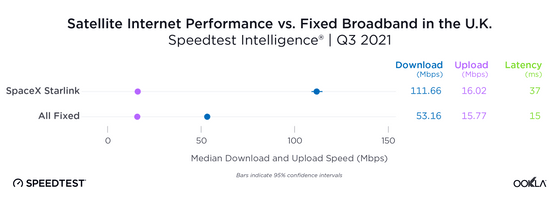
Starlink, which has the momentum to drop flying birds, has launched about 1,700 satellites as of the end of 2021, and plans to eventually build an Internet network with more than 30,000 satellites.
Related Posts:
in Web Service, Posted by log1l_ks







